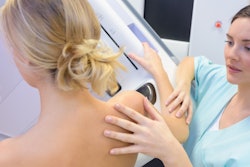Women travel nearly three times as far for supplemental breast MRI or ultrasound screening than for mammography, according to research published August 12 in the American Journal of Preventive Medicine.
A team led by Eric Christensen, PhD, from the Harvey L. Neiman Health Policy Institute in Reston, VA, found that women travel just over eight miles to mammography sites but between 22 and 23 miles to ultrasound and MRI sites for supplemental imaging. This distance may contribute to breast screening disparities, the team highlighted.
"These differences, however, are economically driven. There just isn’t a financial case to justify bringing MR facilities equally close to all women," Christensen told AuntMinnie.com. "Fortunately, there are options to supplemental breast screening if breast MR is not available."
Breast MRI is the preferred supplemental imaging option for high-risk women, but one of the modality’s primary weaknesses is lack of availability for many women. The researchers noted that spatial access differences could contribute to disparities in breast care.
Christensen and colleagues evaluated the relative distance to breast imaging facilities with MRI compared to facilities offering mammography or ultrasound. They used 2023 ZIP code data from the U.S. Food and Drug Administration (FDA) and the American College of Radiology (ACR). The team also used linear regression to assess distance differences controlling for area deprivation index (ADI), urbanicity, and population size.
Final analysis included 29,639 ZIP codes with an ADI and known urbanicity. Patients seeking supplemental MRI would have to travel an average distance of 23.2 miles to a breast MRI facility, while only having to travel an average of 8.2 miles to a mammography site, according to the findings. Additionally, patients would have to travel an average of 22.2 miles to a breast ultrasound site.
“[The] average distance to breast MR facilities was 2.8 times further than to mammography facilities,” the researchers wrote.
The team also found that ADI and urbanicity were tied to increased distance to the nearest breast imaging facility. The additional miles associated with the least advantaged areas compared with most advantaged areas were 12.2 miles for MRI, 11.5 miles for ultrasound, and 2.4 miles for mammography.
Finally, compared with metropolitan areas, the additional miles to breast MRI facilities were 23.2 miles for small/rural areas.
Christensen said these findings could make way for contrast-enhanced mammography (CEM) to be more utilized for women seeking supplemental imaging.
"Bringing CEM closer to women can mitigate the more important outcome disparities. This is a practical solution to a vexing problem," he told AuntMinnie.com. "Obviously, more use of breast ultrasound would help, but the results of the study show that would have limited impact on bringing supplemental breast screening closer to patients given that it is similarly distant from patients as is breast MR."
The team called for future studies to examine the feasibility and effectiveness of such mitigation efforts and other options for addressing breast screening disparities.
"While we are not currently pursuing a specific research study related to this study, we remain committed to understanding the ways in which economics drive disparities and finding practical ways to make improvements for patients," Christensen said.
The study can be found in its entirety here.


.fFmgij6Hin.png?auto=compress%2Cformat&fit=crop&h=100&q=70&w=100)





.fFmgij6Hin.png?auto=compress%2Cformat&fit=crop&h=167&q=70&w=250)











